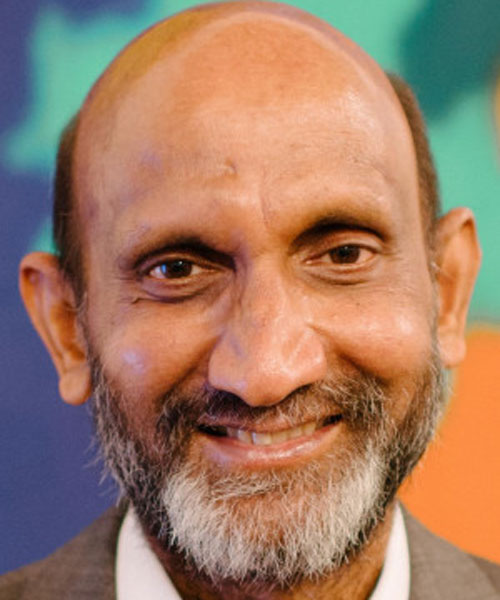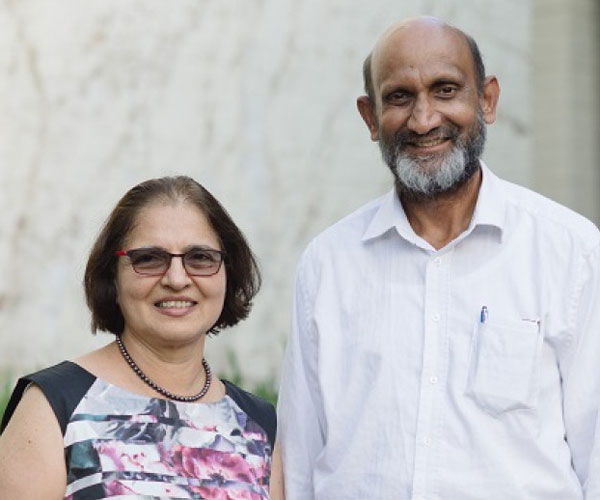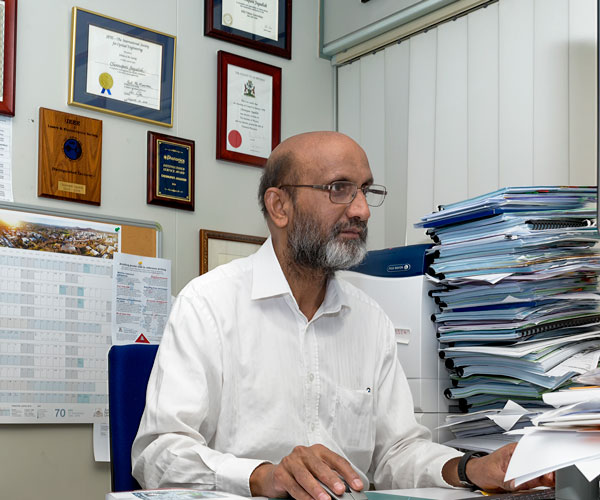
Australian National University (ANU) Distinguished Professor Chennupati Jagadish has been named as the next president of the Australian Academy of Science. Jagadish was born in a small village in the south of India in humble circumstances. His recent appointment is indeed only the most recent accomplishment in a life full of personal fulfilment and scientific success.
"I'm humbled and honoured for this appointment and I want to thank the Australian Academy of Science and my colleagues for choosing me. I do science for humanity and my focus has always been excellence in science, while supporting especially the young generations," he commented.
Jagadish, a TWAS Fellow since 2013 and the Head of the Semiconductor Optoelectronics and Nanotechnology Group at ANU, in Canberra, Australia, is an authoritative voice in the fields of neuroscience and neurotechnology, semiconductor nanotechnology and optoelectronics, and semiconductor photovoltaics.
He was the Founding Director of the Australian National Fabrication Facility (2007–2020), and the Convenor of the Australian Nanotechnology Network. From 2012 to 2016, he served as Vice-President and Secretary of Physical Sciences of the Australian Academy of Science. He was then appointed President of the Australian Materials Research Society for the 2016–2019 term, and served as President of the Institute of Electrical and Electronics Engineers (IEEE) Photonics Society in 2018 and 2019. He has also served as President of the IEEE Nanotechnology Council in 2008 and 2009.
He authored or co-authored more than 980 research papers, holds six US patents, and co-authored or co-edited several books, while he still holds established research collaborations with scientists from more than 30 countries.
Jagadish's life, however, hasn't always been like a glittering path. It began in a rural area in southern India, in a farming family where his father was also a school teacher. When his father left his job to become a full-time farmer in a remote place of India, Jagadish was only 10, and was left in the care of an uncle to further continue his education.
But his village had no high school and Jagadish had to walk six kilometres a day to attend the closest school. This is why, he eventually moved to a neighbouring village, where his maths teacher offered him to live at his place.
Those years shaped Jagadish's temper and disposition. "My maths teacher, Chaganti Sambi Reddy, who is still alive at 87 now, was a very strict person," recalled Jagadish. "He required dedication and hard work. I used to study until late in the night and wake up early in the morning. He showed me the importance of hard work and discipline."
Another prominent figure in Jagadish's life was his English teacher, Valluru Srinivasa Rao, who taught him honesty, simplicity, humbleness and generosity. Along with his father's advice "to aim high", those teachings guided Jagadish throughout his life path.
As a youth, Jagadish recalled, his commitment to education was not very profound. He "goofed around" for several years, he admitted, thinking back of that period. But eventually, he committed himself to science.
He earned his Bachelor of Science degree from Acharya Nagarjuna University, in Guntur, in 1977, his Master of Science degree from Andhra University, in Waltair, in 1980, and his PhD in Physics from the University of Delhi, in 1986. Then he ended up teaching for three years at Sri Venkateswara College, in New Delhi, where he started lecturing students. It was a very rewarding experience: His students still keep in touch with him, which shows how he has impacted their lives.
His father's suggestion to aim high kept driving Jagadish's attitude and, as a consequence, he eventually decided to apply for a new position abroad, to acquire experience and build new connections.
Initially, his career took an unexpected, unpleasant turn. In a time when neither the Internet nor the social media were available, Jagadish used two scientific magazines—Physics Today and IEEE Spectrum—to select prestigious universities offering interesting positions that would allow him to grow scientifically. "I sent more than 300 applications, but I received more than 300 rejection letters," he recalled. "I used to joke: name a University, I certainly have its rejection letter."
Then a friend who was already at Queens University, in Kingston, Canada, suggested writing to Prof. David Atherton, asking for a post-doc position. After six weeks (the time for a letter to go, and for the reply to come back), Jagadish got a position in Canada, to work in the magnetics field, even though his PhD was in semiconductors. It was 1988 when his all-out work period began.
In Canada, he worked 13 hours a day, seven days a week, to prove to Prof. Atherton that his choice had been right, and, after two years of hard work, he could claim 10 scientific papers to his credit. But his Canadian contract was almost over, and India seemed so far in time and space.
Again, life offered Jagadish another opportunity. He applied for and got a two-year position in Prof. Jim Williams's laboratory, in the newly established Department of Electronic Materials Engineering, at the Australian National University in Canberra. With his wife, Vidya, his two-month-old daughter, Laya, and unyielding enthusiasm, he set out again towards a new future. It was in July 1990 when they arrived in Canberra. In two years, he was able to prove his qualities and his scientific drive, which earned him a permanent position in Australia. "I never imagined I would stay in Australia for such a long time," he admitted after more than 30 years, during which his career skyrocketed.
In three decades Jagadish became an undisputed leader in nanotechnology, photonics (the generation and manipulation of light) and quantum dot lasers (lasers that work following the principles of quantum physics). Now, most of all, Jagadish and his team focus on nanowires, where the prefix nano refers to the magnitude of the 'objects' they use, which corresponds to one-billionth of a meter.
Jagadish's team builds nanowire lasers, nanowire photodetectors and nanowire solar cells. They also use nanowires to split water and produce hydrogen, and nanowires as electrodes to study neuronal functions.
Nanowires, he clarified, are useful to study neurodegenerative diseases like Alzheimer's. "When we grow neurons on top of an array of ordered nanowires, their long extensions called axons grow beautifully, forming a regular pattern," said Jagadish. "But when they grow on a simple flat surface, they move randomly."
Why? The reason behind this difference is not clear yet, but in the frame of a collaboration started three years ago with The Dementia Australia Research Foundation, the scientist hopes he will succeed in spotting important differences between healthy cells and cells from patients with Alzheimer's disease.
The ambitious goal is to create so-called mini-brains (or brain organoids) that reproduce different neurological behaviours. "We want to help people with Alzheimer's, therefore we need to understand how the neurons work and what are the signalling differences between neurons from healthy people and people with Alzheimer's."
In the photonics field, the aim is to generate and manipulate light, by changing its intensity, polarization (the motion of propagation of light), and phase (light's wavelength). Applications are countless. "We can create holographic images during remote conversations, to give the impression of standing in front of a real, three-dimension person. And we can develop particular lasers for fast and secure quantum communications."
Quantum communication is a pioneering form of sending information from one place to another far away, in a safe fashion. If someone tries to steal that information, the system destroys itself, because the message is sent in a quantum-by-quantum mode, preceded by a code that dictates the way each photon moves: disrupting this flow by trying to steal one photon is equivalent to disrupting the message itself.
Due to his unceasing passion for science, Jagadish is now an honorary member of many universities, including the Indian Institute of Technology Hyderabad, the National Taiwan University, the University of Electronic Science and Technology of China, and the University of Oxford.
He is also the winner of the 2015 IEEE Pioneer in Nanotechnology Award, the 2015 IEEE Photonics Society Engineering Achievement Award, the 2016 Silver Jubilee International Award from the Materials Research Society of India, and is the 2016 Distinguished Fellow of the Chinese Academy of Sciences President's International Fellowship Initiative.
Jagadish's interests are not restricted only to science. Along with his wife, he engages in various charity activities. Every year, for example, they donate some solar lamps to Solar Aid, an international charity founded in 2006 to combat poverty and climate change in Africa.
There are more than 700 million people without electricity, in the world; donations help poor African families, and children, in particular, live a better life. Those lamps, in fact, can be charged in the daylight and used at night, thus avoiding dangerous alternatives such as kerosene lamps, which are toxic, and which were especially used by young students to do their homework.
Jagadish and his wife also support the Pollinate Group, which trains Indian and Nepalese women to become entrepreneurs. "If you want to have a better world and society you have to empower women," maintained Jagadish. "And if you wish to help others, make their dreams and goals true."
Kiva is another organization that the Jagadishs support: it was created in 1992 to help workers from disadvantaged social groups. "If entrepreneurs need financial support, even small amounts, to expand their shop, or buy a cow or a buffalo to produce milk, several people in different countries give money to a local financing agency, which then distributes the money to those who have requested it," the scientist explained, adding that, to date, he and his wife have helped more than 2,200 people in 79 countries, mainly focusing on women.
Science, of course, remains the major goal in Jagadish's life. This is what prompted him and his wife to start the Chennupati and Vidya Jagadish endowment fund that supports students from developing countries, who go to Australia, access state-of-the-art facilities, and are mentored by leading experts in their fields of physics.
Their initiative then prompted ANU to launch the Future Research Talent awards that give selected Indian and Indonesian students the opportunity to pursue collaborative research at ANU, for 10–12 weeks. So far, the programme has supported 52 students from India and one from Indonesia.
"My pride and joy are my students, and seeing their success makes me very happy," Jagadish said. This is why, he writes reference letters twice a week for people all over the world, trying to give back the support he received many years before.
"I always asked myself: how could I impact people's lives? What legacy do I want to leave behind? And my answer is: I have to do good things for others. And even if you do not look for it, good will come back to you."
Cristina Serra

